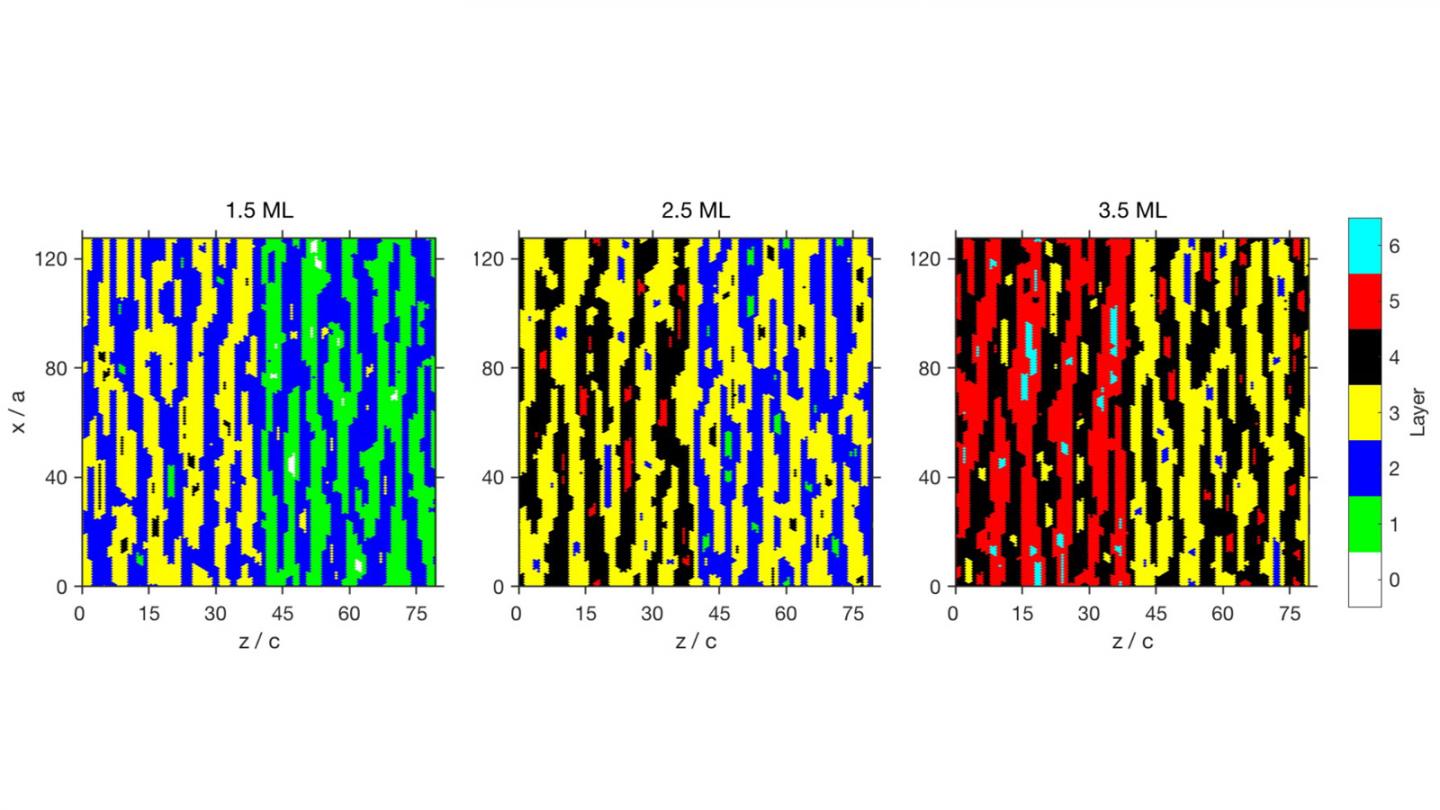
Credit: Argonne National Laboratory
Argonne scientists reveal connections as crystalline layers form.
Understanding how crystals grow impacts broad areas of materials science, from developing better microelectronics to discovering new materials. At the atomic level, crystals can grow in several different ways, and scientists have recently discovered an intriguing behavior associated with a common way that crystals grow.
In this mode of crystal growth, called ““layer-by-layer,” the surface of the crystal starts out very smooth at the atomic level. New atoms that arrive on the surface tend to skate around until they find each other. When this happens, they begin to form a new one-atom-thick layer by joining, creating a flat region known as an island. As more atoms arrive, additional islands form at other places on the surface. Eventually the growing islands cover the whole surface, coalescing to form a new atomic layer.
“If we understand how crystals grow in this mode, we might be able to better understand some of the mechanisms behind defect formation, as well as develop techniques to synthesize new types of crystals.” — Peter Zapol, Argonne materials scientist
In a new study from the U.S. Department of Energy’s (DOE) Argonne National Laboratory, scientists have found that the seemingly random arrangement of islands that form to begin new layers can actually be very similar from layer to layer.
Using coherent X-ray scattering techniques to observe the crystal surface at the atomic scale during crystal growth, the researchers were able to characterize the exact arrangements of the islands as they form, or ?“nucleate,” in each layer of the crystal.
“You can think of what we’re doing as something like making pancakes in a pan,” said Argonne Distinguished Fellow and study author Brian Stephenson. ?“As we randomly add more atomic ?‘batter,’ our pancake islands start to run together and coalesce. The interesting thing is that every time we grow a new layer, the pattern of pancakes repeats the pattern of the original layer.”
One important consideration that Stephenson noted is that the nucleation of new islands was not influenced by defects in the crystal structure — which is to say, it was not controlled by static regions where nucleation would be most likely to occur.
“This is a dynamic relationship; the layer that is almost completely grown communicates with the layer that is beginning to grow on top of it,” said Argonne physicist Peter Zapol, another author of the study.
As the lower layer continues to fill in, the remaining holes tend to occur in areas far away from the original nucleation sites. Because these holes discourage next-layer nucleation in their vicinity, nucleation of the next layer will tend to take place far away from the holes and close to the original nucleation sites.
“The persistent patterns that we see indicate that there is communication between the layers,” Stephenson said. ?“There is a vestige of the first layer that gives information to the next one.”
The ability to characterize the island patterns comes as a result of the researchers’ use of coherent X-rays provided by Argonne’s Advanced Photon Source, a DOE Office of Science User Facility. According to Stephenson, incoherent X-rays used in previous experiments were able to reveal only average features of the island landscape, while coherent beams are sensitive to the exact island arrangement.
“The old way just told us the average spacing and shape of the islands — with coherent X-ray beams, we’re able to generate a whole lot more information,” he said. ?“The resolution has gotten so good that we’re now able to resolve correlations across the whole sample, which means we can see things like this pattern that tell us how the islands relate to each other.”
Modeling growth dynamics at the atomic level helped the researchers achieve a deeper understanding of crystal growth, Zapol said. ?“If we understand how crystals grow in this mode, we might be able to better understand some of the mechanisms behind defect formation, as well as develop techniques to synthesize new types of crystals.”
A paper based on the study, “Coherent X-ray spectroscopy reveals the persistence of island arrangements during layer-by-layer growth,” appeared in the March 4 issue of Nature Physics. Other Argonne authors included Guangxu Ju, Dongwei Xu, Matthew Highland, Jeffrey Eastman, Paul Fuoss, and Hua Zhou. Carol Thompson from Northern Illinois University and Hyunjung Kim from Sogang University in South Korea also contributed.
###
Support for the research was provided by DOE‘s Office of Science.
Argonne National Laboratory seeks solutions to pressing national problems in science and technology. The nation’s first national laboratory, Argonne conducts leading-edge basic and applied scientific research in virtually every scientific discipline. Argonne researchers work closely with researchers from hundreds of companies, universities, and federal, state and municipal agencies to help them solve their specific problems, advance America’s scientific leadership and prepare the nation for a better future. With employees from more than 60 nations, Argonne is managed by UChicago Argonne, LLC for the U.S. Department of Energy’s Office of Science.
The U.S. Department of Energy’s Office of Science is the single largest supporter of basic research in the physical sciences in the United States and is working to address some of the most pressing challenges of our time. For more information, visit the Office of Science website.
Media Contact
Chris Kramer
[email protected]
Original Source
https:/
Related Journal Article
http://dx.




